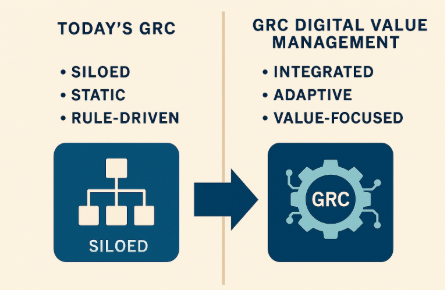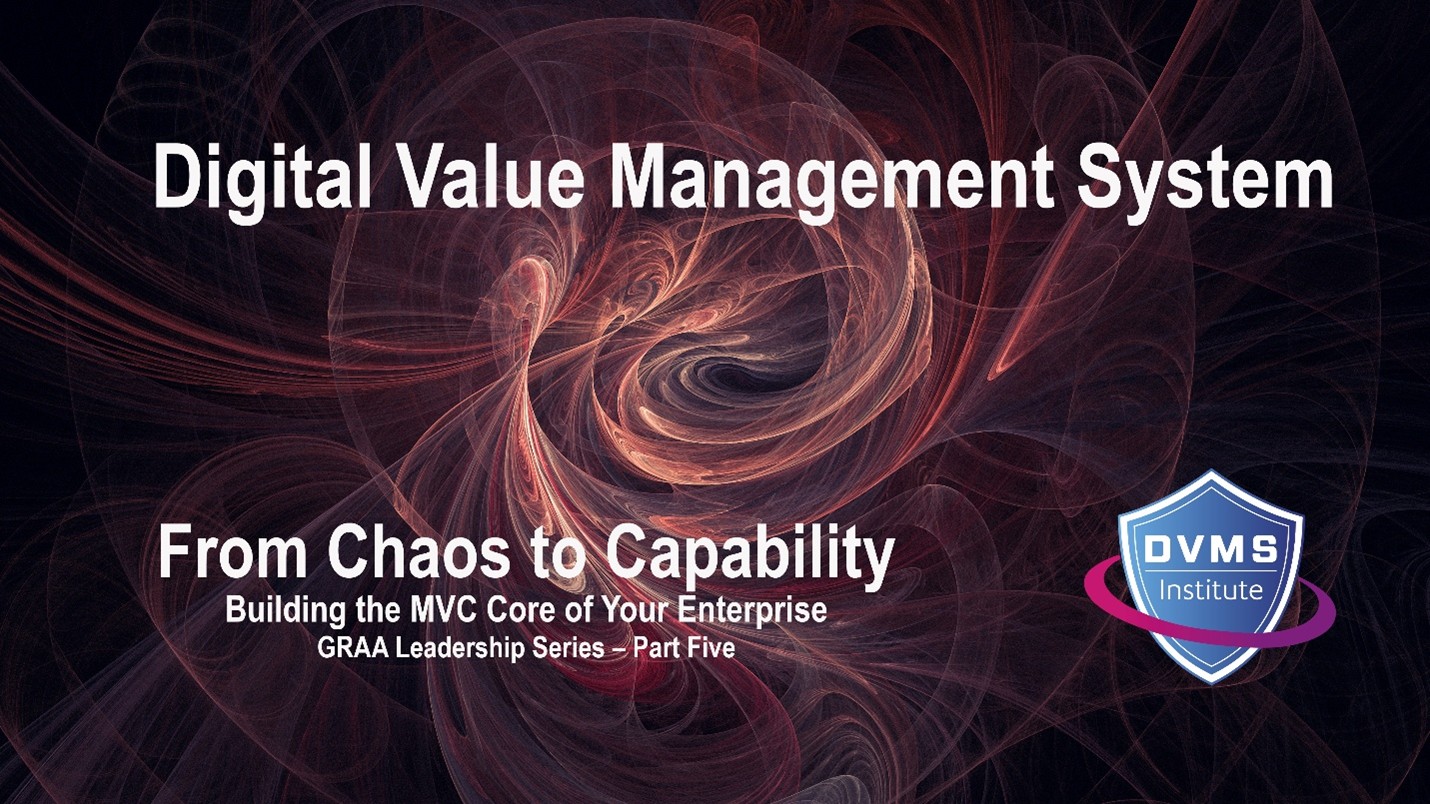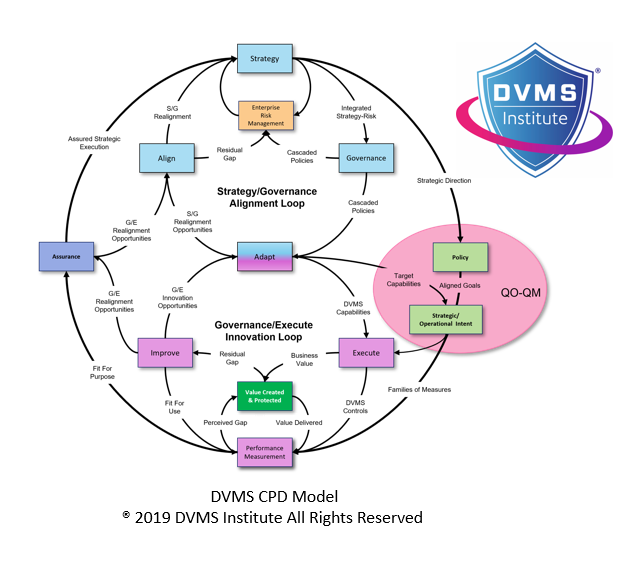Digital Value Management – An Integrated, Adaptive, and Culture-Aligned Approach for Modern-Day GRC
Rick Lemieux – Co-Founder and Chief Product Officer of the DVMS Institute
Introduction: The Evolving Demands of Digital Business
In the digital age, organizations operate in increasingly complex ecosystems defined by rapid technological change, interconnected supply chains, and ever-rising stakeholder expectations. Digital transformation has created extraordinary opportunities for innovation and growth, but it has also introduced new forms of vulnerability, regulatory scrutiny, and ethical challenges. Against this backdrop, Governance, Risk, and Compliance (GRC) is no longer a back-office function—it is a strategic capability that touches every aspect of a digital business. However, GRC must be integrated, adaptive, and culture-aligned to be effective, ensuring that it evolves alongside the company, empowers resilience, and fosters trust across the entire digital ecosystem.
Integration: Breaking Down Silos in the Digital Enterprise
Digital businesses cannot afford fragmented governance, isolated risk management, or siloed compliance functions. Integration is the first requirement for a mature GRC system because risks and obligations are interdependent. For example, implementing a new AI-powered platform involves governance choices about accountability, risk considerations about bias and cybersecurity, and compliance requirements related to privacy laws such as GDPR. If each function operates in isolation, the organization faces duplication of effort, inconsistent reporting, and blind spots that expose it to systemic risks.
An integrated GRC approach provides a unified framework where strategy, governance, risk, and compliance reinforce one another. Policies are linked to risks, risks are tied to controls, and controls are mapped to regulatory obligations. This holistic view ensures decision-makers have visibility across the enterprise, enabling smarter investments, faster responses to disruption, and more effective assurance to stakeholders. Integration reduces inefficiency and strengthens the enterprise by aligning its digital strategy with its operational and regulatory realities.
Adaptability: Thriving in a Rapidly Changing Environment
The digital landscape is defined by constant change. New technologies emerge, cyber threats evolve, and regulations are rewritten at a pace that challenges even the most mature organizations. Static or rigid GRC frameworks quickly become obsolete. This is why adaptability is essential.
An adaptive GRC system is designed to evolve alongside the organization and its environment. It incorporates continuous monitoring, dynamic risk assessment, and agile policy management. For instance, when a business moves workloads to the cloud, an adaptive GRC system can quickly map the new risks, adjust compliance controls, and realign governance policies. Similarly, if new data privacy legislation is enacted, adaptive GRC allows for the timely integration of these obligations into operational practices without disrupting business continuity.
Adaptability ensures that governance, risk, and compliance are not barriers to innovation but enablers of safe, sustainable growth. By embedding adaptability into GRC, organizations position themselves to experiment, scale, and innovate without undermining security, trust, or resilience.
Culture Alignment: Embedding GRC into the Digital Ecosystem
Perhaps the most overlooked dimension of GRC is cultural alignment. A GRC framework that is not embedded in an organization’s culture is likely to be ignored, resisted, or applied superficially. In digital business, culture determines how people make decisions, manage risks, and meet compliance requirements daily.
Culture-aligned GRC ensures that governance principles, risk awareness, and compliance obligations are part of the organizational mindset rather than external impositions. Employees at all levels understand their role in protecting digital assets, maintaining ethical practices, and safeguarding trust. Leadership models the behaviors that encourage transparency, accountability, and proactive risk management. Partners and vendors are engaged as part of the extended digital ecosystem, ensuring that systemic risks are managed collectively rather than in isolation.
When GRC is aligned with culture, it shifts from being a burdensome requirement to a source of shared responsibility and pride. It empowers employees to raise concerns, fosters collaboration across departments, and creates an environment where compliance and resilience are considered drivers of long-term value rather than constraints.
Governance: Aligning Decisions with Strategy and Trust
At the heart of integrated, adaptive, and culture-aligned GRC lies governance. Governance ensures that decisions align with organizational strategy, ethical principles, and stakeholder expectations. In digital business, this means setting clear standards for data usage, defining accountability for AI-driven decisions, and ensuring that digital investments are consistent with long-term goals.
Strong governance establishes the foundation for transparency and trust. It helps organizations navigate complex trade-offs, such as balancing innovation with security or speed-to-market with regulatory obligations. Governance also assures investors, regulators, and customers that the organization responsibly manages its digital ecosystem. Without governance, risk management and compliance become reactive and fragmented; with governance, they become strategic and aligned.
Risk: Managing Uncertainty Across Complex Ecosystems
Risk is an unavoidable reality in digital business. From cyberattacks and system outages to supply chain disruptions and regulatory breaches, risks can undermine operations, damage reputation, and erode customer trust. What distinguishes resilient organizations is not the absence of risk but the ability to manage it systematically and proactively.
An integrated and adaptive GRC framework embeds risk awareness into decision-making at every level. Risks are identified, assessed, and prioritized in alignment with strategy. Controls are implemented and tested continuously, and scenarios are developed to ensure preparedness for potential disruptions. By doing so, risk management is about avoiding harm and enabling agility and innovation.
When risk is managed well, organizations can confidently enter new markets, adopt emerging technologies, and engage in digital partnerships. In this way, risk becomes a strategic enabler rather than a constraint.
Compliance: Meeting Obligations and Building Digital Trust
Though often viewed as the most rigid component of GRC, compliance is a dynamic enabler of digital trust. Regulatory requirements such as GDPR, HIPAA, and industry-specific mandates are designed to protect consumers, data, and critical infrastructure. Meeting these obligations demonstrates accountability and builds confidence with regulators, customers, and partners.
In an integrated, adaptive, and culture-aligned GRC system, compliance is embedded into processes rather than bolted on. Continuous monitoring and automation ensure that compliance keeps pace with evolving regulations. Culture alignment ensures that employees view compliance not as a burden but as a commitment to doing business responsibly.
Ultimately, compliance is not just about avoiding penalties but about sustaining trust in digital business ecosystems. Without trust, customers will hesitate to share data, partners will hesitate to collaborate, and regulators will impose stricter oversight. Compliance, therefore, becomes a cornerstone of digital competitiveness.
Technology as an Enabler of Modern GRC
Technology amplifies the effectiveness of integrated, adaptive, and culture-aligned GRC. Automation reduces manual effort, advanced analytics provide real-time insights, and AI enhances predictive risk assessment. Modern GRC platforms connect policies, risks, controls, and compliance obligations into a single record system, providing visibility across the entire enterprise.
This technological enablement transforms GRC from a static, backward-looking activity into a dynamic, forward-looking capability. For example, predictive analytics can identify emerging risks, while AI-driven monitoring can highlight potential compliance gaps before violations occur. Cloud-based GRC platforms also ensure scalability and agility, supporting global operations and complex ecosystems.
Conclusion: Integrated, Adaptive, and Culture-Aligned GRC is the DNA of Digital Business
Integrated, adaptive, and culture-aligned governance, risk, and compliance are not optional in digital business—they are essential. By breaking down silos, ensuring adaptability, and embedding GRC into organizational culture, companies create a framework that touches every aspect of their operations. Governance aligns decisions with strategy, risk management enables resilience and agility, and compliance sustains trust. Together, they form the DNA of digital business, helping organizations survive in a complex digital landscape and thrive with integrity, innovation, and confidence.
About the Author

Rick Lemieux
Co-Founder and Chief Product Officer of the DVMS Institute
Rick has 40+ years of passion and experience creating solutions to give organizations a competitive edge in their service markets. In 2015, Rick was identified as one of the top five IT Entrepreneurs in the State of Rhode Island by the TECH 10 awards for developing innovative training and mentoring solutions for boards, senior executives, and operational stakeholders.
In today’s digitally driven economy, cyber disruptions are no longer an “if” but a “when.”
The DVMS Institute’s Certified Training Programs teach organizations the skills to transform static, fragmented, and control-based (NIST, ISO, ITSM, GRC, etc.) Governance, Risk, and Compliance (GRC) programs into an Integrated, Adaptive, and Culture-Aligned GRC Digital Value Management Overlay System® capable of enabling digital business operations during digital disruption.
Through the DVMS MVC, CPD, and 3D Knowledge Models, the DVMS transforms existing GRC programs into an integrated, adaptive, and culture-aligned GRC Digital Value Management System® that powers Operational Resilience, Regulatory Compliance, and Digital Trust across complex supply chains.

Enabling an integrated, adaptive, and culture-aligned GRC system demands more than frameworks—it requires the seamless connection of Strategy, Governance, and Operations, supported by active participation from every member of the digital ecosystem. Together, they anticipate and mitigate the systemic risks that threaten the digital enterprise’s resilience, compliance, and trust.
By adopting this forward-looking, integrated, and culture-aligned approach to governance, risk, and compliance, businesses are positioned to:
- Maintain Operational Stability Amidst Constant Digital Disruption
- Deliver Digital Value, and Trust Across A Digital Ecosystem
- Satisfy Critical Regulatory and Certification Requirements
- Leverage Cyber Resilience as a Competitive Advantage
DVMS Explainer Videos
- Architecture Video: David Moskowitz explains the DVMS System
- Case Study Video: Dr. Joseph Baugh Shares His DVMS Story.
- Overlay Model – What is an Overlay Model
- MVC ZX Model – The MVC’s that power operational resilience
- CPD Model – Adaptable governance and assurance
- 3D Knowledge Model – Enabling holistic organizational learning
- FastTrack Model – A phased approach to cyber resilience
Digital Value Management System® is a registered trademark of the DVMS Institute LLC.
® DVMS Institute 2025 All Rights Reserved




